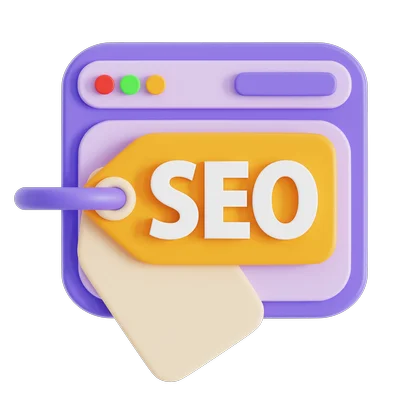Which On Page Element Carries the Most Weight for SEO? (Spoiler: It’s Not What You Think!)

In the vast digital landscape, websites jostle for visibility – vying for a chance to rise above the algorithm’s tide and reach their intended audience. This is where the enigmatic art of SEO, or Search Engine Optimization, comes into play.
Definition of SEO (Search Engine Optimization)

Think of SEO as a whisperer to the search engine gods, influencing their favor. It’s the meticulous practice of optimizing a website’s content and structure to rank higher in search results – essentially putting your website on the map for relevant searches. This translates to organic, targeted traffic – the lifeblood of any online venture.
Importance of on-page elements in SEO
But SEO isn’t a monolithic entity. It’s a finely woven tapestry, and on-page elements are its shimmering threads. These elements, residing within the actual website, serve as signposts for search engines, helping them understand the page’s content and relevance. Think of it as speaking the search engine’s language, ensuring your message resonates clearly.
From the captivating title tag to the informative meta description, every on-page element plays a crucial role. Strategic keyword placement within the content acts as a bridge, connecting your website to relevant search queries. Images, with their descriptive alt text, add another layer of understanding, while internal linking stitches your website together, demonstrating its depth and value.
Purpose of determining the weight of on-page elements
But not all elements hold equal weight in the SEO kingdom. Understanding their relative importance – their “weight” – is key to optimizing your website effectively. A well-researched title tag may hold more sway than a keyword-stuffed paragraph, while optimized images can trump generic headers. Knowing where to concentrate your efforts ensures you’re not just whispering, but shouting at the top of your SEO lungs.
By determining the weight of each element, you can create a strategic plan, allocating resources and crafting content that truly speaks to the search engine’s heart. This journey requires careful analysis, constant adaptation, and a healthy dose of data-driven insights. It’s a game of chess, one where understanding the weight of your pieces is crucial for checking the rankings.
This is just the beginning of our exploration into the fascinating world of on-page SEO. Buckle up, as we delve deeper into the intricacies of each element, uncovering their hidden power and unleashing your website’s full potential in the competitive search engine landscape.
Mastering Your Title Tag
The title tag, that tiny snippet of text at the top of your browser window, is the silent salesperson of your website. It’s the first impression you make on search engines and potential visitors, and its power shouldn’t be underestimated. Let’s dive into the world of title tags and unlock their full SEO potential.
Definition and Role in SEO:
Think of your title tag as the headline of a newspaper article. It should be concise, compelling, and accurately reflect the content of your page. It’s the first thing users see in search engine results pages (SERPs) and social media shares.
![Title tag example in a search engine result page]
But its role goes beyond just grabbing attention. For search engines, it’s a crucial signal of your page’s relevance to a specific query. The more relevant your title tag is to the user’s search intent, the higher the chance of your page appearing at the top of the results.
Impact on Search Engine Rankings:
While not the sole factor in determining your ranking, a well-optimized title tag can give you a significant boost in the SERPs. Here’s why:
- Relevance: Search engines prioritize pages with titles that closely match the user’s search query. Including relevant keywords in your title tag tells the algorithm your page is exactly what they’re looking for.
- Click-Through Rate (CTR): A compelling title tag entices users to click on your link, even if you’re not ranked first. This tells the search engine that your page is valuable and relevant, potentially boosting your ranking over time.
- User Experience: A clear and informative title tag sets the user’s expectations for your page. If it accurately reflects the content, they’re more likely to stay engaged and find what they’re looking for.
Best Practices for Optimizing Title Tags:
Now that you know the power of a great title tag, let’s explore some tips to craft one that shines:
- Keep it concise: Aim for 50-60 characters, including spaces, to avoid getting cut off in search results.
- Include relevant keywords: Use 1-2 primary keywords naturally within the title.
- Write for humans, not just robots: Focus on clarity and user appeal, not just keyword stuffing.
- Use action verbs: Encourage clicks with active language.
- Differentiate yourself: Stand out from the competition with unique and informative titles.
- Test and refine: Use data and A/B testing to see what title tags resonate best with your audience.
Bonus Tip: Add a call to action (CTA) to your title tag to further incentivize clicks, like “Ultimate Guide to…” or “Download Your Free Ebook Now!”
By following these best practices, you can transform your title tags from silent salespeople into SEO superheroes, attracting both search engines and users alike. Remember, a well-crafted title tag is an investment that will pay off in increased visibility and engagement for your website.
Go forth, conquer the SERPs, and let your title tags lead the way!
Heading Tags: Structure and SEO Superpowers
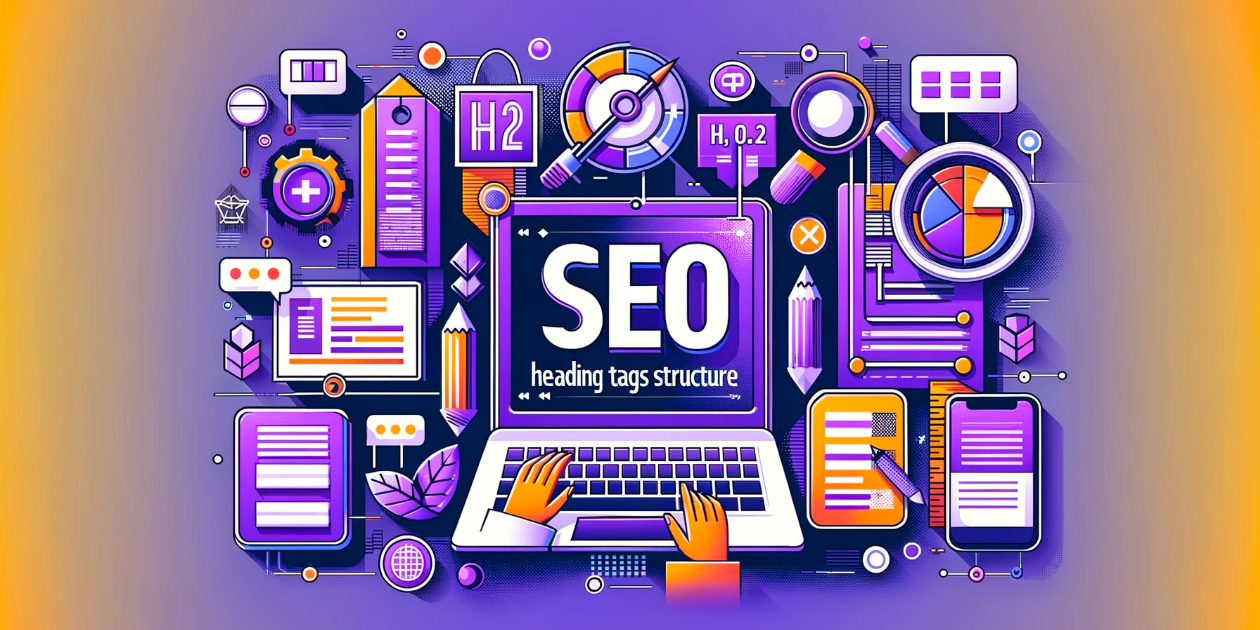
Imagine diving into a dense jungle without a map. Content without heading tags is like that – overwhelming and confusing for both readers and search engines. Thankfully, heading tags act as your trusty compass, guiding users through your content and highlighting key points for search engines to understand.
Structuring Content with Clarity:
Think of heading tags (H1 to H6) as a hierarchy of importance. H1 is your main title, like a bold headline in a newspaper. H2s are your subheadings, similar to chapter titles in a book. H3s and beyond further drill down into specific sections.
This structure benefits both readers and search engines:
- Readers: Heading tags break up text, making it easier to scan and navigate. They act as signposts, highlighting key points and improving comprehension.
- Search Engines: Heading tags signal the content’s structure and topic relevance. Search engines crawl your page, using headings to understand the hierarchy and context of your information.
SEO Boost from Proper Heading Tags:
Using heading tags effectively isn’t just about aesthetics; it’s an SEO superpower. Here’s how:
- Keyword Targeting: Integrate relevant keywords naturally within your headings. This tells search engines what your content is about and improves your page’s relevance for specific searches.
- Content Organization: Heading tags provide a clear outline of your content, making it easier for search engines to crawl and index your pages.
- Improved User Experience: Well-structured content with clear headings keeps users engaged and reduces bounce rates, which can positively impact your SEO ranking.
Optimizing Heading Tags for Search Engines:
Now, let’s equip your headings with SEO superpower armor:
- H1: The King of Headlines: Your H1 tag should be concise, compelling, and accurately reflect your page’s main topic. Include your primary keyword naturally.
- H2s: Subheading Subtitles: Use H2s to break down your content into subsections and highlight key points. Include relevant keywords strategically.
- H3s and Beyond: Deeper Dives: H3s and lower tags further organize your content within subsections. They can use more specific keywords but don’t force it.
Bonus Tip: Use a variety of heading levels to avoid a monotonous structure. Think of it like creating a symphony with different instruments!
Remember, heading tags are your allies in the quest for SEO and user engagement. Use them wisely, and watch your content rise to the top of the search engine jungle!
Content: The SEO Crown Jewel
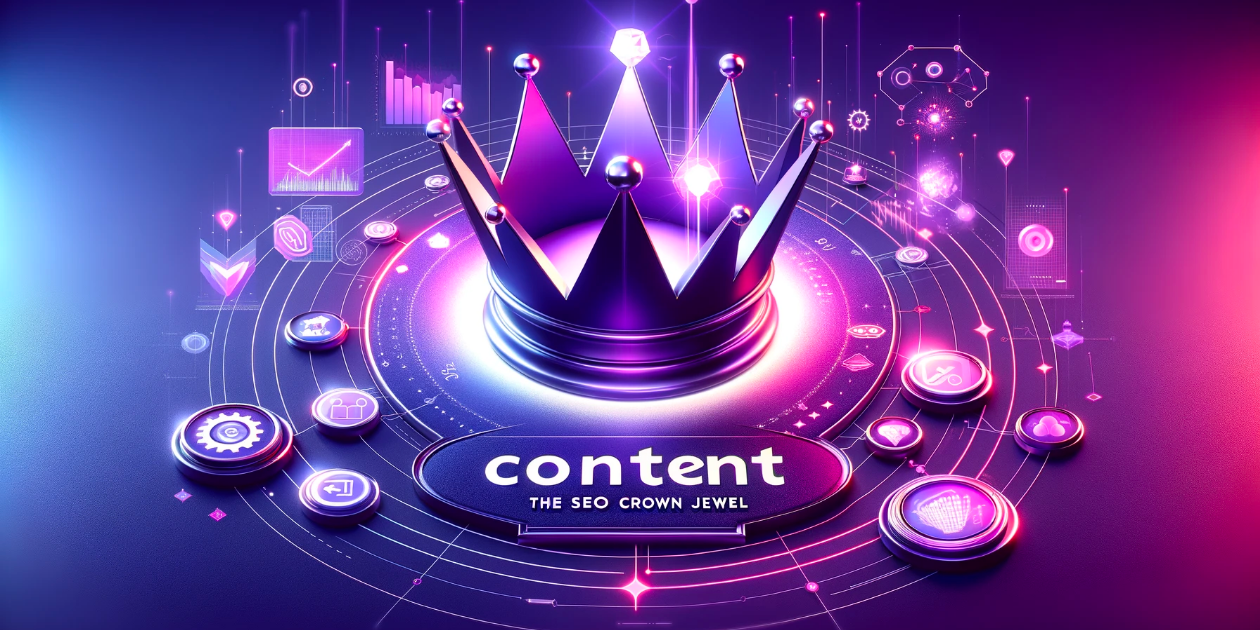
In the kingdom of SEO, content reigns supreme. It’s the heart and soul of your website, the magnet that attracts users and the whisper that speaks to search engines. But not all content is created equal. To truly flourish in the SERPs, you need quality content – a shining gem cut from the rough.
The Power of Quality Content:
Think of quality content as a delicious feast laid out for your audience. It should be:
- Informative: Provide valuable, accurate, and relevant information that solves user queries and adds to their knowledge.
- Engaging: Captivate readers with a clear, concise, and interesting writing style. Use storytelling, humor, or visuals to keep them hooked.
- Unique: Stand out from the crowd with original ideas, insights, and perspectives. Offer something your competitors don’t.
- Fresh: Keep your content updated and relevant to stay ahead of the curve. Regular updates show search engines and users that your site is active and dynamic.
- Optimized: Integrate relevant keywords strategically throughout your content, but don’t overdo it. Prioritize natural user experience over keyword stuffing.
Keywords: Tools of the Trade:
Keywords are your bridge to the search engine kingdom. They’re the terms users type in to find what they need, and your content needs to speak their language. But keywords are more than just magic spells – they need to be used wisely:
- Research: Understand your target audience and their search intent. Find relevant keywords with high search volume but low competition.
- Target: Choose a primary keyword and strategically integrate it throughout your content, including the title tag, headings, and body text. Use secondary keywords and related terms naturally to broaden your reach.
- Context: Don’t force keywords. Ensure they flow naturally within your content and make sense for the reader.
Engagement: The Search Engine Whisperer:
Search engines don’t just listen to your content; they watch how users interact with it. User engagement signals like dwell time, bounce rate, and click-through rate tell them whether your content is truly valuable:
- Dwell Time: If users spend a significant amount of time on your page, it tells search engines your content is engaging and relevant.
- Bounce Rate: A high bounce rate means users leave your page quickly, indicating your content may not be meeting their needs.
- Click-Through Rate: If users click on your link from the search results page, it suggests your content is enticing and relevant to their query.
By crafting quality content that engages users and signals relevance to search engines, you’ll unlock the true power of SEO. Remember, content is your voice, your story, your bridge to success. Make it your masterpiece, and watch your website rise to the top of the search engine kingdom.
Bonus Tip: Utilize multimedia elements like images, videos, and infographics to break up text, improve engagement, and provide a richer user experience.
Let your content be your crown jewel, shining brightly in the realm of SEO!
The Unsung Hero of SEO: Mastering the Meta Description

While flashy titles and captivating content steal the spotlight, a hidden hero toils away in the SEO shadows: the meta description. This short snippet of text, nestled beneath your page title in search results, is often underestimated, but its influence on click-through rates (CTRs) is undeniable. Let’s unlock the secrets of this SEO champion and craft meta descriptions that drive traffic to your website.
Meta Description: Definition and Purpose:
Imagine you’re browsing a bustling online marketplace. Each stall displays a catchy sign (the title) and a brief product description (the meta description). This is exactly what search results pages look like. Your meta description is your chance to entice searchers with a glimpse into what your page offers, convincing them to step into your “stall” and explore further.
Impact on Click-Through Rates:
Consider this: 70% of searchers click on results based solely on the title and meta description. That’s right, those few lines of text hold immense power! A compelling meta description can be the difference between getting lost in the crowd and standing out like a beacon.
Best Practices for Crafting Captivating Meta Descriptions:
Here are some tips to transform your meta descriptions from dull to dazzling:
- Keep it concise: Aim for 155-160 characters to avoid getting cut off in search results.
- Focus on relevance: Ensure your description accurately reflects your page’s content and includes relevant keywords naturally.
- Appeal to user intent: Understand what users are searching for and address their specific needs in your description.
- Call to action: Include a subtle CTA like “Learn More” or “Download Now” to nudge users towards clicking.
- Uniqueness matters: Stand out from the competition with a fresh and engaging voice.
- Test and refine: Use A/B testing to see which meta descriptions resonate best with your audience.
Bonus Tip: Use Google’s Search Console to track your meta descriptions’ performance and see how they influence click-through rates.
Remember, your meta description is a miniature billboard for your website. Make it sizzle with relevance, intrigue, and a touch of persuasion, and watch those click-through rates soar!
Visual Aid:
Imagine two search results for the same query:
- Result 1: Title: “SEO Tips for Beginners” | Meta Description: “Learn basic SEO strategies to boost your website ranking and attract more visitors.“
- Result 2: Title: Master SEO & Skyrocket Your Traffic in 2024! | Meta Description: Unlock the secrets to dominating search engines and attracting hordes of eager customers. Click here to claim your FREE SEO guide!“
Which result are you more likely to click on? The second one, of course! It uses strong verbs, promises quick results, and offers a freebie, all within the character limit. This is the power of a well-crafted meta description.
By mastering this often-overlooked SEO element, you can transform your website from a silent observer to a click magnet, attracting a steady stream of visitors and achieving your online goals. Now go forth and write meta descriptions that make your website shine!
Demystifying the Maze: Building SEO-Friendly URL Structures

In the labyrinthine world of SEO, the URL isn’t just a random address – it’s a crucial pathway leading search engines and users to your content. A clean and relevant URL acts as a roadmap, guiding them effortlessly to your treasure trove of information. Let’s explore the art of crafting SEO-friendly URLs that pave the way for ranking success.
The Value of a Clear and Relevant URL:
Imagine stumbling upon a cryptic address like “<invalid URL removed>” instantly telling its story. It’s user-friendly, keyword-rich, and signals precisely what lies within.
Best Practices for SEO-Friendly URLs:
Here are some tips for crafting URLs that shine:
- Keep it short and sweet: Aim for less than 60 characters to avoid getting cut off in search results.
- Use descriptive language: Include relevant keywords naturally within the URL to give search engines and users a clear idea of your content.
- Hyphens are your friends: Separate words with hyphens, not underscores, for better readability.
- Ditch unnecessary elements: Avoid parameters, session IDs, and other clutter that dilutes the clarity of your URL.
- Mirror your page structure: Use subdirectories and path structures that logically reflect your website’s hierarchy.
The URL and Ranking Connection:
While URL structure isn’t a direct ranking factor for search engines, it impacts SEO in several ways:
- User Experience: A clear URL boosts user engagement by setting expectations and making navigation easier. This can indirectly influence ranking metrics like dwell time and bounce rate.
- Keyword Targeting: Incorporating relevant keywords within your URL sends clear signals to search engines about your page’s content, potentially improving its relevance for specific searches.
- Crawlability: A well-structured URL helps search engine crawlers understand your website’s hierarchy and index your pages more efficiently.
Bonus Tip: Use Google Search Console’s URL inspection tool to check your URL structure and identify any potential SEO issues.
Remember, your URL is the first impression you make online. Make it a good one by crafting it with clarity, relevance, and SEO in mind. By building a user-friendly URL roadmap, you’ll guide search engines and visitors directly to your content, paving the way for ranking success and engaging experiences.
Remember, the perfect URL is like a well-baked pie:
- Short and sweet: The crust shouldn’t be too thick.
- Deliciously descriptive: Fill it with juicy keywords.
- Easy to navigate: Divide it into clear slices with hyphens.
- Visually appealing: Don’t forget the garnish of relevance and user experience.
Bake your URLs with these principles in mind, and watch your website become the SEO bakery everyone wants to visit!
Unleashing the Power of Images: SEO with a Visual Spark

In the realm of SEO, words reign supreme, but visuals play a crucial role in captivating users and boosting your search engine standing. Enter images – vibrant windows into your content, offering a break from text and amplifying your message. But beyond aesthetics, optimizing images and their alt text unlocks a hidden SEO treasure trove.
The Allure of Images:
Humans are visual creatures, processing images 60,000 times faster than text. By strategically using images, you can:
- Break up text monotony: Visuals add variety and prevent your content from becoming a text wall.
- Boost engagement: Compelling images grab attention and entice users to delve deeper into your content.
- Improve comprehension: Pictures can convey complex information more effectively than words alone.
- Increase social sharing: Visually rich content is more likely to be shared on social media, expanding your reach.
SEO Secrets Hidden in Alt Text:
Alt text, those descriptive sentences attached to your images, aren’t just for visually impaired users. They’re SEO gold, whispering to search engines what your image is all about. Think of it as a caption under your picture, helping search engines understand the context and relevance of your visual content.
Optimizing Alt Text for SEO:
Here are some strategies to turn your alt text into powerful SEO tools:
- Be descriptive: Don’t just use generic terms like “image” or “photo.” Describe the image in detail, including relevant keywords.
- Focus on user intent: Think about what users searching for your topic might expect to see in an image.
- Keep it concise: Aim for 125 characters or less to avoid getting cut off in search results.
- Use natural language: Speak like a human, not a robot. Avoid keyword stuffing and focus on clarity.
- Vary your descriptions: Don’t repeat the same alt text for different images.
Bonus Tip: Use synonyms and related keywords in your alt text to expand your reach.
Remember, alt text is like a secret message to search engines. Craft it carefully, and watch your images shine in the SERPs!
Further Strategies for Effective Image SEO:
- Image file names: Choose descriptive and keyword-rich names instead of generic numbers or codes.
- Image format: Use the appropriate format (e.g., JPEG for photos, PNG for graphics) to balance quality and file size.
- Image size: Optimize image size for faster loading times to avoid impacting user experience and SEO.
- Image sitemap: Submit a sitemap listing your images to help search engines discover and index them more efficiently.
By harnessing the power of images and optimizing them for SEO, you can create a visually compelling and search engine-friendly website that attracts, engages, and ranks higher in the SERPs. Remember, images are more than just pretty pixels; they’re potent SEO tools waiting to be unleashed!
Let your website bloom with vibrant visuals and optimized alt text, and watch your SEO success soar!
Weaving Your Web: The Power of Internal Linking in SEO

Imagine your website as a sprawling castle, filled with valuable treasures (your content) scattered across numerous rooms. Internal linking acts as the network of secret passages connecting these rooms, allowing visitors and search engines to navigate effortlessly and unlock the full potential of your website. Let’s delve into the world of internal linking and discover its secrets to enhanced SEO and user experience.
Internal Linking: Definition and Significance:
Internal linking refers to the practice of hyperlinking from one page on your website to another. These links serve multiple purposes:
- Improving Website Navigation: Imagine stumbling through a castle without any maps or signs. Internal links act as signposts, guiding users to relevant content and ensuring they don’t get lost in the labyrinth of your website.
- Boosting SEO: Search engines “crawl” your website by following links, discovering and indexing your content. A well-linked website helps search engines understand your site structure and the relationships between your pages, potentially influencing your ranking for relevant searches.
- Distributing PageRank: Think of PageRank as a digital currency your website earns from external links pointing to it. Internal linking distributes this PageRank throughout your website, ensuring all your content gets some SEO juice, not just the most popular pages.
The Impact on User Experience:
Effective internal linking isn’t just about SEO; it’s about user-friendliness. By seamlessly connecting relevant pages, you can:
- Increase dwell time: Users stay engaged and explore more of your website, boosting your SEO metrics.
- Reduce bounce rate: Frustrated users won’t abandon your website if they can easily find what they’re looking for.
- Improve brand authority: A well-linked website with valuable content establishes you as a thought leader in your field.
Best Practices for Internal Linking for SEO:
Remember, internal linking is an art, not a science. Here are some tips to turn your website into a masterpiece:
- Link relevantly: Don’t just stuff keywords into your anchor text. Choose specific phrases that naturally connect the linked pages.
- Target a variety of pages: Link to high-value pages, new content, and even underperforming pages to give them a SEO boost.
- Use different link types: Text links, image links, and button links offer variety and keep users engaged.
- Monitor your links: Broken links can frustrate users and hurt your SEO. Use tools to track and fix broken links regularly.
Bonus Tip: Analyze your website’s analytics to see how users navigate your site and identify opportunities for strategic internal linking.
Internal linking is like weaving a magical tapestry on your website, one thread at a time. By linking thoughtfully and strategically, you can create a user-friendly experience, distribute SEO juice, and ultimately lead visitors to the hidden treasures within your online castle. So, grab your metaphorical needle and thread, and start weaving your web of internal linking success!
Remember, a well-linked website is a happy website, and happy websites rank higher in the search engine kingdom. Start linking today and watch your SEO magic unfold!
The Speed Demon of SEO: Unleashing the Power of Fast-Loading Pages
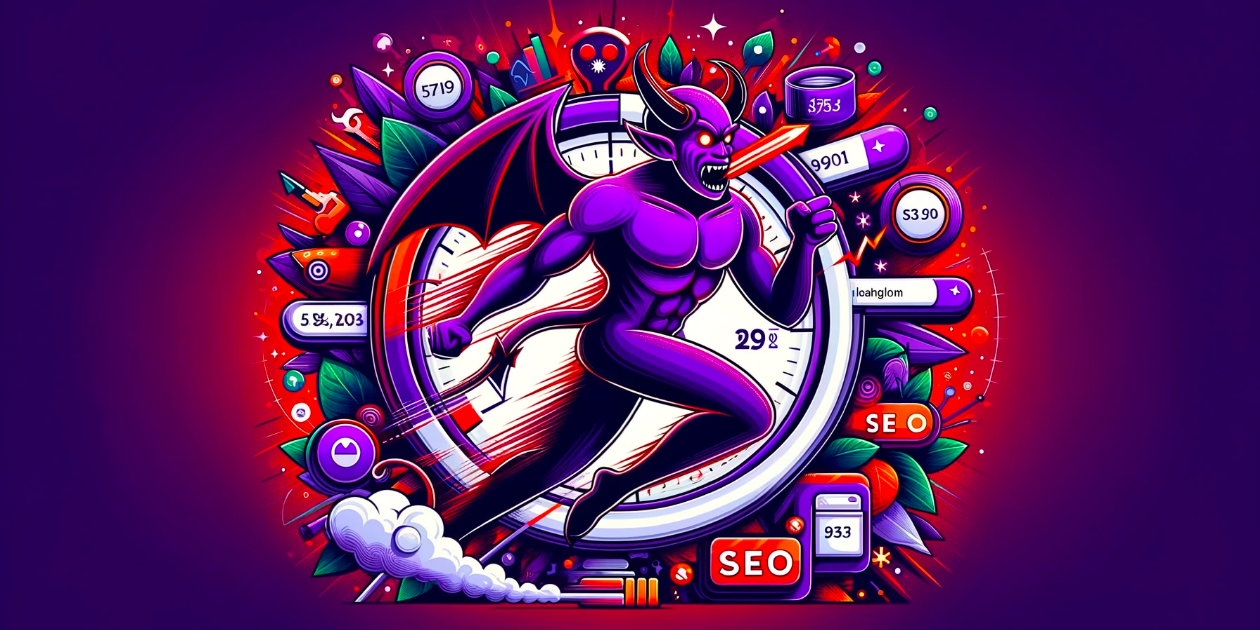
In the fast-paced online world, patience is a rare commodity. Users expect websites to load lightning-fast, and Google rewards speedy sites with higher search engine rankings. Enter page loading speed, the forgotten superhero of SEO, with the power to make your website shine in the SERPs.
Why Speed Matters in SEO:
Think of your website as a restaurant. Nobody enjoys waiting an eternity for their food. Similarly, slow-loading pages frustrate users, increase bounce rates, and send them fleeing to your competitors. But it’s not just about user experience; Google considers page speed a crucial ranking factor. Faster websites climb the search ladder, leaving sluggish ones trailing behind.
Speed Bumps on the Road to SEO:
Several factors can slow down your website:
- Large images: Unoptimized images are heavy baggage, dragging down your loading times.
- Too many scripts and plugins: Every script and plugin adds weight to your site, impacting its speed.
- Inefficient server: A weak server struggles to handle traffic, causing delays.
- Untidy code: Messy code is like tangled spaghetti, taking longer for browsers to process.
Strategies to Turbocharge Your Website:
Fear not, website owner! Here are some ways to unleash the speed demon within your pages:
- Optimize your images: Compress images without sacrificing quality, resize them for screen resolution, and avoid unnecessary graphics.
- Minimize scripts and plugins: Analyze which scripts and plugins are truly essential and eliminate those that create unnecessary bloat.
- Upgrade your server: Invest in a robust server that can handle your website’s traffic flow efficiently.
- Minify your code: Remove unnecessary spaces, characters, and formatting from your HTML, CSS, and JavaScript files.
- Enable browser caching: This allows browsers to store certain website files locally, reducing download times for repeat visitors.
- Leverage a content delivery network (CDN): A CDN delivers your website content from servers closest to your users, minimizing travel time and speeding up loading.
Bonus Tip: Use website speed testing tools like Google PageSpeed Insights to diagnose speed issues and track your progress.
Remember, a fast-loading website is a happy website, and happy websites rank higher. By implementing these strategies, you can transform your website into a speed demon, leaving users and search engines impressed, and soaring to the top of the SERPs. So, ditch the lag and embrace the power of speed!
Imagine the difference:
- Slow website: Imagine a snail serving spaghetti at a crowded restaurant. Frustrated customers leave, never to return.
- Fast website: Picture a lightning-fast chef crafting delicious meals. Happy customers devour their food, come back for more, and tell their friends.
Which scenario do you want for your website?
Choose speed, unleash the SEO superhero within, and watch your web domain flourish!
Mobile Magic: Mastering SEO in the Age of Pocket Screens

Imagine navigating a dense jungle with a bulky map, struggling to decipher its details on your tiny phone screen. That’s what an unoptimized website feels like on a mobile device. Today, with smartphones ruling the digital landscape, mobile-friendliness has become the golden key to SEO success. Let’s explore the secrets of mobile optimization and unlock your website’s full potential in the era of pocket screens.
The Rise of the Mobile Mighty:
The statistics speak for themselves: over 60% of all web searches happen on mobile devices. If your website isn’t mobile-friendly, you’re essentially shutting the door on a vast majority of potential visitors. This not only impacts user experience, but also your SEO ranking. Google, the search engine overlord, prioritizes mobile-first indexing, meaning your mobile website version is the one primarily crawled and ranked. Neglect it, and you’ll be lost in the search jungle, unseen by the mobile masses.
Mobile-First Indexing: A Ranking Revolution:
Think of mobile-first indexing as a new map designed for the digital jungle. Google prioritizes websites that offer a seamless experience on mobile devices, ensuring users find what they need quickly and easily. This shift puts the onus on website owners to prioritize mobile optimization, crafting an experience that delights users and satisfies search engine algorithms.
Best Practices for Mobile SEO Mastery:
Now, armed with knowledge, let’s equip your website with the tools for mobile SEO success:
- Responsive design: Implement a responsive design that automatically adjusts to different screen sizes, delivering an optimal experience on any device.
- Fast loading times: Mobile users on the go are impatient. Optimize images, minimize redirects, and leverage caching to ensure lightning-fast loading speeds.
- Finger-friendly layout: Ditch tiny buttons and cluttered interfaces. Prioritize large tap targets and intuitive navigation for easy interaction on touchscreens.
- Readability first: Optimize font sizes and line spacing for easy reading on smaller screens. Avoid excessive text walls and break up content with visuals.
- Mobile-friendly forms: Make sure forms are accessible and easy to fill on mobile devices. Reduce form fields and simplify the submission process.
Bonus Tip: Use Google’s Mobile-Friendly Test tool to check your website’s mobile friendliness and identify areas for improvement.
Remember, mobile optimization isn’t just a technical hurdle; it’s a user-centric journey. By prioritizing mobile users’ needs and ensuring a smooth, enjoyable experience, you pave the way for higher rankings, increased engagement, and ultimate SEO success.
Picture this:
- Unoptimized website: Users struggle to navigate a clunky website on their phones, frustrated and abandoning the experience.
- Mobile-optimized website: Visitors seamlessly engage with a beautiful, responsive website, finding what they need quickly and easily.
Which scenario paints a brighter picture for your SEO future? Embrace the mobile magic, optimize your website for pocket screens, and watch your digital jungle become a thriving oasis for visitors and search engines alike!
let the mobile revolution guide your SEO strategy, and witness your website rise to the top of the search engine kingdom, one perfectly sized pixel at a time!
Conquering the On-Page SEO Jungle: A Recap and Journey Forward
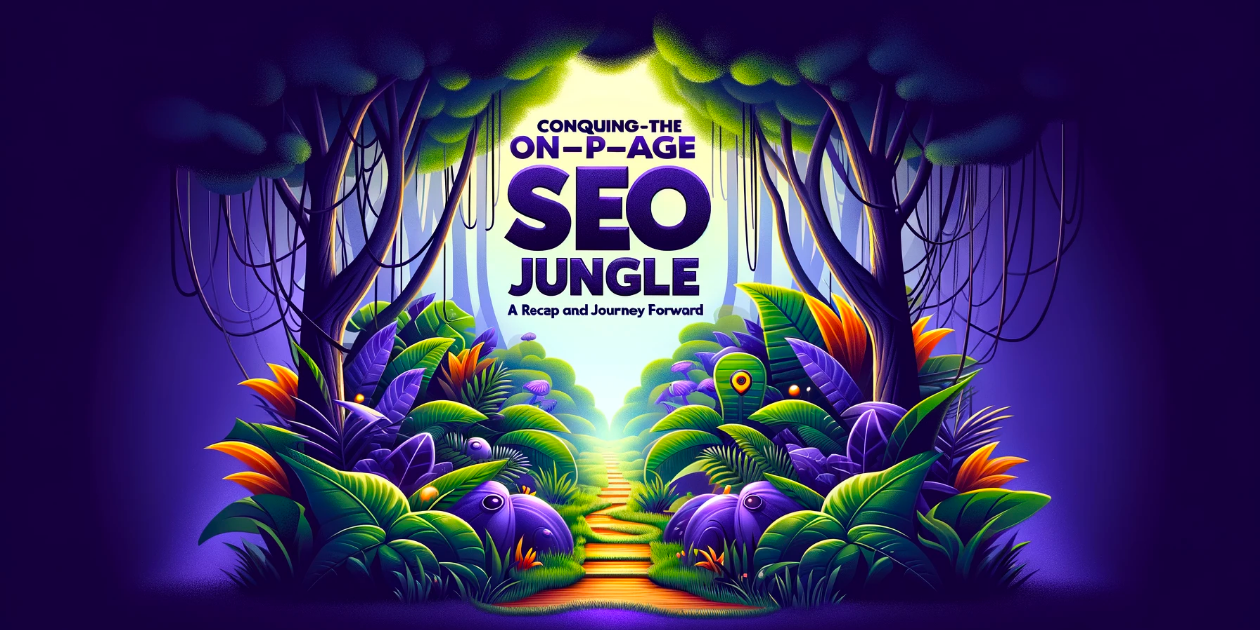
We’ve embarked on a thrilling journey through the dense jungle of on-page SEO, unveiling the vital elements that empower your website to rise above the digital foliage and bask in the sunlight of top search engine rankings. Let’s recap our key takeaways:
The Mighty On-Page Elements:
- Content: The king of the jungle, informative, engaging, and optimized for your target audience.
- Keywords: Your compass, guiding search engines and users to your content. Use them strategically, not like machetes hacking through text.
- Headings: Signposts outlining your content’s structure, keeping users oriented and search engines informed.
- URLs: Your path leading to the content, is clear, concise, and relevant to your page’s topic.
- Meta Descriptions: A captivating glimpse into your content, enticing users to click and explore.
- Images and Alt Text: Vibrant windows into your website, optimized with descriptive alt text for accessibility and SEO visibility.
- Internal Linking: The secret passages connecting your pages, improving user experience, and boosting SEO juice distribution.
- Page Loading Speed: The cheetah of SEO, delivering content faster than lightning to keep users and search engines satisfied.
- Mobile Optimization: Adapting your website to the smartphone jungle, providing a seamless experience for the majority of web explorers.
Balancing the SEO Scale:
Remember, on-page SEO isn’t just about throwing every element into the mix like ingredients in a jungle stew. Finding the right balance is key:
- Prioritize quality over quantity: Focus on creating valuable content that truly benefits your audience.
- Target keywords strategically: Don’t force them, integrate them naturally where they enhance user experience.
- Optimize with user-friendliness in mind: Every element should serve a purpose, making your website a joy to navigate, not a frustrating puzzle.
- Use data to guide your decisions: Analytics and testing reveal what works and what doesn’t, allowing you to refine your SEO approach.
Continuous Monitoring and Adaptation:
The journey doesn’t end with initial optimization. The SEO jungle is constantly evolving, and so should your strategy:
- Track your website’s performance: Utilize tools like Google Search Console and Analytics to stay updated on your rankings, traffic, and user behavior.
- Adapt to algorithm updates: Google’s search engine algorithms frequently change, requiring flexibility and adjustments to your optimization tactics.
- Embrace testing and experimentation: Try different strategies, analyze the results, and refine your approach to find what works best for your website.
Remember, conquering the on-page SEO jungle is a continuous quest, not a one-time adventure. By understanding the elements, finding the right balance, and adapting to the evolving landscape, you can empower your website to thrive, attract visitors, and climb to the top of the search engine kingdom. So, keep your machete sharp, your compass handy, and your SEO spirit ablaze! The rewards for conquering the jungle await.
I hope this recap has been a valuable guide to your on-page SEO journey. Feel free to ask any further questions you may have, and let’s continue exploring the exciting world of search engine optimization together!



